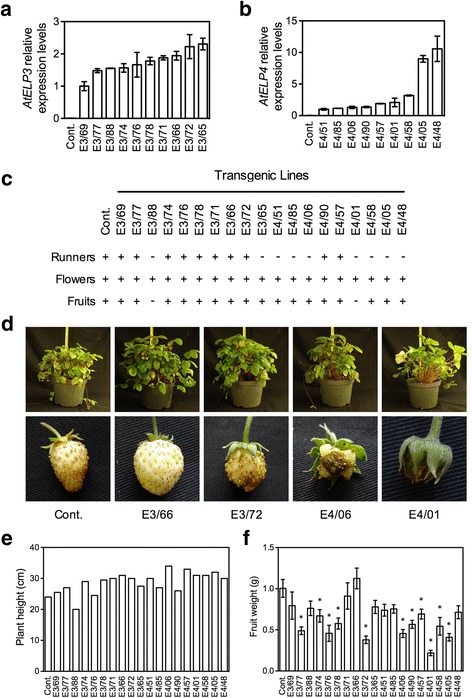Fig. 1.

Molecular and morphological characterization of transgenic F. vesca plants expressing AtELP3 and AtELP4. a and b Expression levels of AtELP3 (a) and AtELP4 (b) in independent AtELP3 (E3) and AtELP4 (E4) transgenic F. vesca lines. No AtELP3 and AtEL4 expression was detected in the non-transformed control (Cont.). The order of the transgenic lines is presented in order of increasing expression levels of the transgene. Expression of the transgene was normalized against the constitutively expressed EF1α gene. The resulting average values of E3/69 and E4/51 were arbitrarily set as 1 in (a) and (b), respectively, and other lines were compared with E3/69 or E4/51 to show the relative expression levels of the transgenes. Data represent the average of three biological replicates with standard deviation (SD). The experiments were repeated with similar trends. c Presence (+) or absence (−) of runners, flowers, and fruit on the AtELP3 (E3) and AtELP4 (E4) transgenic plants. The order of the transgenic lines is the same as in Fig. 1a and b. d Plant (top) and fruit (bottom) morphology of two AtELP3 (E3/66 and E3/72) and two AtELP4 (E4/06 and E4/01) transgenic lines as well as the non-transformed control (Cont.). e and f Plant height (e) and fruit weight (f) of one-year-old AtELP3 (E3) and AtELP4 (E4) transgenic plants. The fruit weight data in (f) represent the average of 20 strawberries with SD. An asterisk indicates significant difference between the transgenic line and the non-transformed control (Cont.) (Student’s t-test, p < 0.05)
